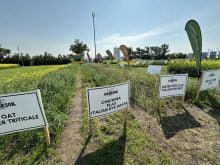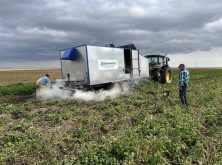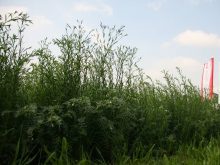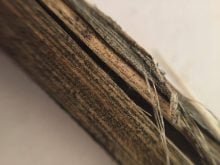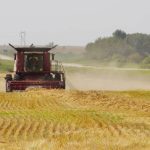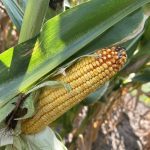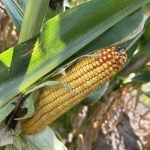Kochia’s latest herbicide resistance — this time to Group 14 products — could make weed control trickier, especially for no-till farms.
“It means more products; it means a lot more management,” Manitoba Agriculture weed extension specialist Kim Brown says. “Realistically, the sooner we get out in front of this, the better.”
Kochia is a fast-spreading tumbleweed that has become a major problem for farmers in the plains regions on both sides of the border. It thrives in dry conditions, emerges early in the season and produces large numbers of seeds.
Read Also

Protect wheat, barley and oats from allergen contamination
Mixing allergenic crops into cereals can harm trade and consumer safety. Keep it Clean outlines practices to reduce risks on the farm.
Group 14 herbicides, such as Authority, Heat and Valtera, target the protoporphyrinogen oxidase (PPO) enzyme and cause rapid desiccation by disrupting a plant’s chlorophyll production.
Dose-response study
Group 14 resistance in kochia is a recent development. It was first discovered on a farm near Kindersley, Sask. in 2021. The following year, it was independently discovered at two different locations in North Dakota. At that point, researchers at Agriculture and Agri-Food Canada began working with researchers from North Dakota State University to develop a cross-border dose-response study, which released its results in March this year.
Researchers tested kochia from Saskatchewan and North Dakota, including herbicide-resistant and susceptible plants, under controlled greenhouse conditions. They sprayed them with two Group 14 herbicides at various doses to see how well they worked.
The study confirmed what everyone suspected: those kochia populations were highly resistant to the Group 14 herbicides tested (saflufenacil and carfentrazone). In Saskatchewan, resistant plants from Kindersley had 57- to 87-fold resistance, meaning they needed 57 to 87 times more saflufenacil to get the same effect as normal susceptible plants.
The same pattern held with carfentrazone. Kindersley plants needed up to 120 times the normal dose for similar control. In North Dakota, even the highest herbicide rates weren’t enough — 50 to 76 per cent of plants still survived.
How resistance spreads
Charles Geddes, an AAFC research scientist and lead researcher on the dose-response study, says that so far in Canada, group 14-resistant kochia has only been confirmed in two fields: the original one in Saskatchewan and another in Alberta, confirmed in 2023.
But based on preliminary data from the latest Prairie-wide kochia survey, which began last fall, he suspects the issue is now present in multiple fields in Saskatchewan. And given how quickly glyphosate resistance spread in kochia, he expects it will soon be confirmed in other regions as well.
“We suspect, just given the history, that this type of resistance will likely spread quickly as well,” Geddes says.
Geddes, who works out of AAFC’s Lethbridge research centre, says they’ve done some yet-to-be-published research into the mechanisms behind how the resistance spreads.
Resistance in kochia can show up in more than one way, he says. Sometimes, it evolves independently — a random mutation in a single plant lets it survive a herbicide spray. If that plant sets seed and similar products keep getting used, resistant plants gradually take over.
But resistance doesn’t just develop on its own. It can also spread from field to field. Kochia is a tumbleweed, so when mature plants break off and roll across the landscape, they scatter seeds — including those carrying resistance traits. On top of that, kochia can cross-pollinate with other plants. A resistant plant flowering near a susceptible one can pass resistance through pollen.
That’s why Geddes says farmers across the Prairies could soon see Group 14-resistant kochia in their fields.
“Farmers should keep an eye out for it when they’re scouting,” Geddes warns. “If they notice a lack of control, I would encourage them to collect a sample and get it tested for resistance so they know what they’re dealing with.”
The problem for no-till operations
Researchers did dose-response work on both soil-applied and foliar-applied Group 14s. While Geddes points out that the resistance is stronger for foliar-applied, it’s still present for the soil-applied. And that is why it’s a big concern for no-till operations across the prairies.
Geddes explains that no-till and min-till growers have relied heavily on glyphosate as a preemergent burn-down product for kochia. With kochia quickly developing resistance to glyphosate, the strategy became to add in another mode of action. Often, those products were Group 14s.
“Pre-plant burndown herbicide options become limited when glyphosate resistance and Group 14 resistance are present in a kochia population,” Geddes says. “Since tillage is effective for kochia management, one concern could be a reversion to more tillage-intensive systems in areas that have made a lot of progress with no-till.”
In fact, one reason Geddes says Manitoba, sandwiched between Saskatchewan and North Dakota, has yet to discover Group 14 resistance in kochia is that farms in the province rely less on no-till strategies, particularly in the Red River Valley.
“Tillage actually works quite well against kochia, because it can’t emerge from very deep in the seed bank, but it still germinates,” Geddes says. “So if it germinates when it’s buried, then the seed just doesn’t survive.”

But Brown says Manitoba farmers shouldn’t assume they’re in the clear. In fact, she fully suspects the resistance is already in Manitoba—it just hasn’t been confirmed yet.
“We use tillage a lot less than some places in Saskatchewan, so we are less reliant on some pre-emerge herbicides. But we do use those products, and we have a lot of kochia,” notes Brown. “I would be very shocked if we didn’t have any here.”
Integrated weed management
Since the discovery of kochia’s Group 14 resistance, Brown says, she’s been working hard to raise awareness of the issue. And when she’s asked when the issue will become serious enough for farmers make changes to their weed management strategies, she says waiting isn’t an option; regardless of which province they’re in. It’s the same story with any herbicide-resistance issue.
“You need to assume it’s here now,” she says. “We needed to start changing things years ago.”
Brown says farmers can still use Group 14 products but will need to start adding different groups, stop relying heavily on groups where resistance is growing and start thinking about integrated weed management strategies.
“We need to make changes before it becomes a problem,” she says. “If we do everything we can to reduce weeds, not through the spray tank, but through everything else, we can get cleaner, less weedy fields and have less to spray.”
Some cultural control options the Manitoba Agriculture website lists for kochia include delayed seeding, or pre-seeding tillage because kochia germinates early in the season. It also suggests rotating between early- and late-seeded crops, or switching up seeding dates year to year to keep populations in check. Since most kochia seeds don’t last more than a year, even stopping seed set for a single season can make a real difference. Cutting for feed or mowing can be effective too, as long as it’s done before the plant goes to seed.
With no new herbicide modes of action on the horizon, Brown says it’s important to extend the effectiveness of the ones that are still available — and the way to do that is to use them less.
“If we start doing all those things, it’ll help these herbicides last longer.” she says.
If those sprayless strategies do involve incorporating tillage, Brown emphasizes it must be strategic and appropriate tillage, acknowledging there are negative consequences for tillage — but if used properly, it’s a very effective tool.
“We need to use it in the right place at the right time,” Brown says. “Even in the drier areas, where they’ve been full-blown no-till or minimum till, there are times when tillage is the right tool.”
Looking ahead
Geddes says researchers are now working on a quick genetic test that would allow farmers to submit leaf tissue samples to find out whether the resistance trait is present in their kochia populations.
His team is also studying cross-resistance to see which other Group 14 herbicides are affected. The next step, says Geddes, is finding alternatives.
“We’re figuring out what alternative management practices can be used when it comes to managing kochia — and specifically at that pre-plant window, where these Group 14 products are used most,” he says.




